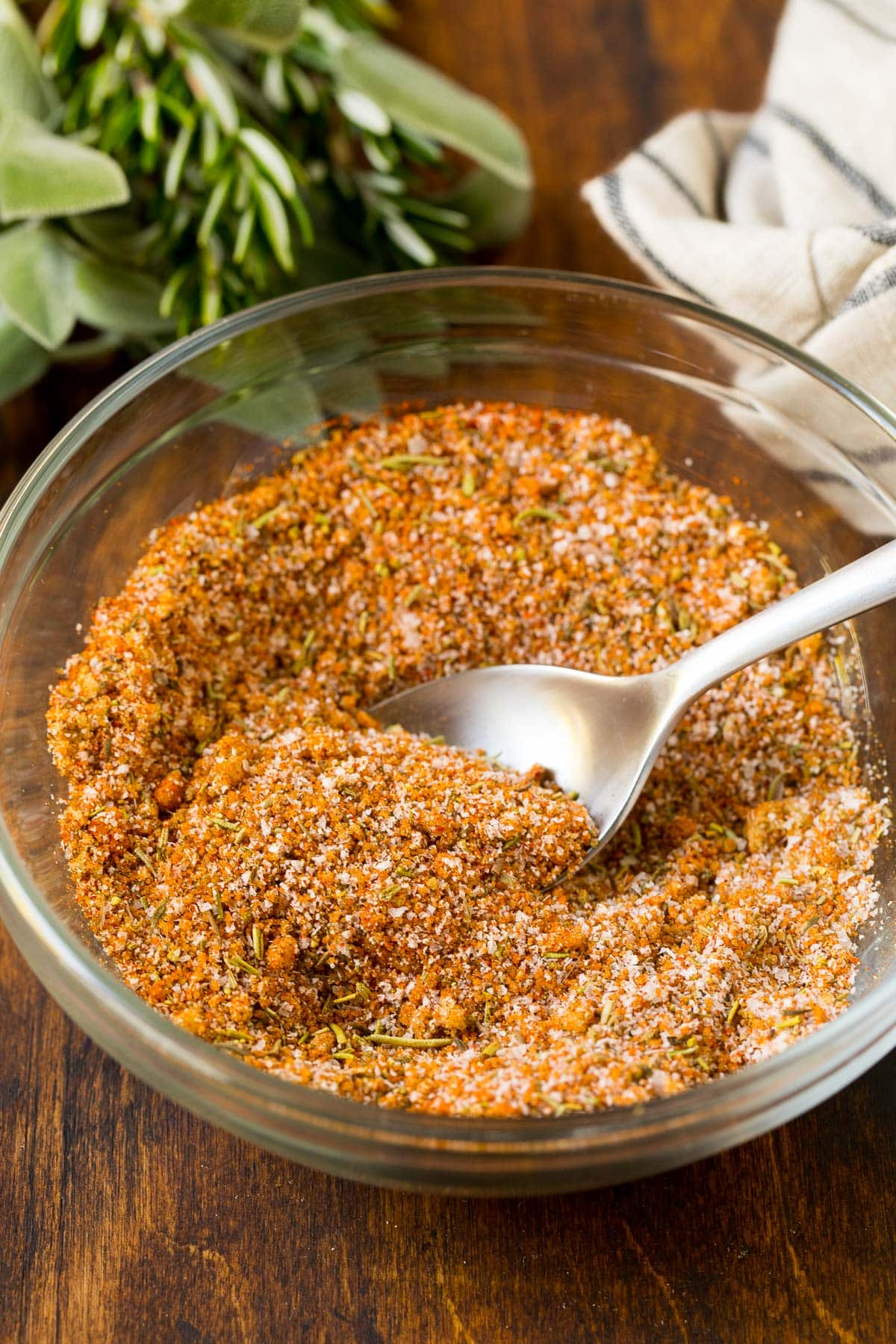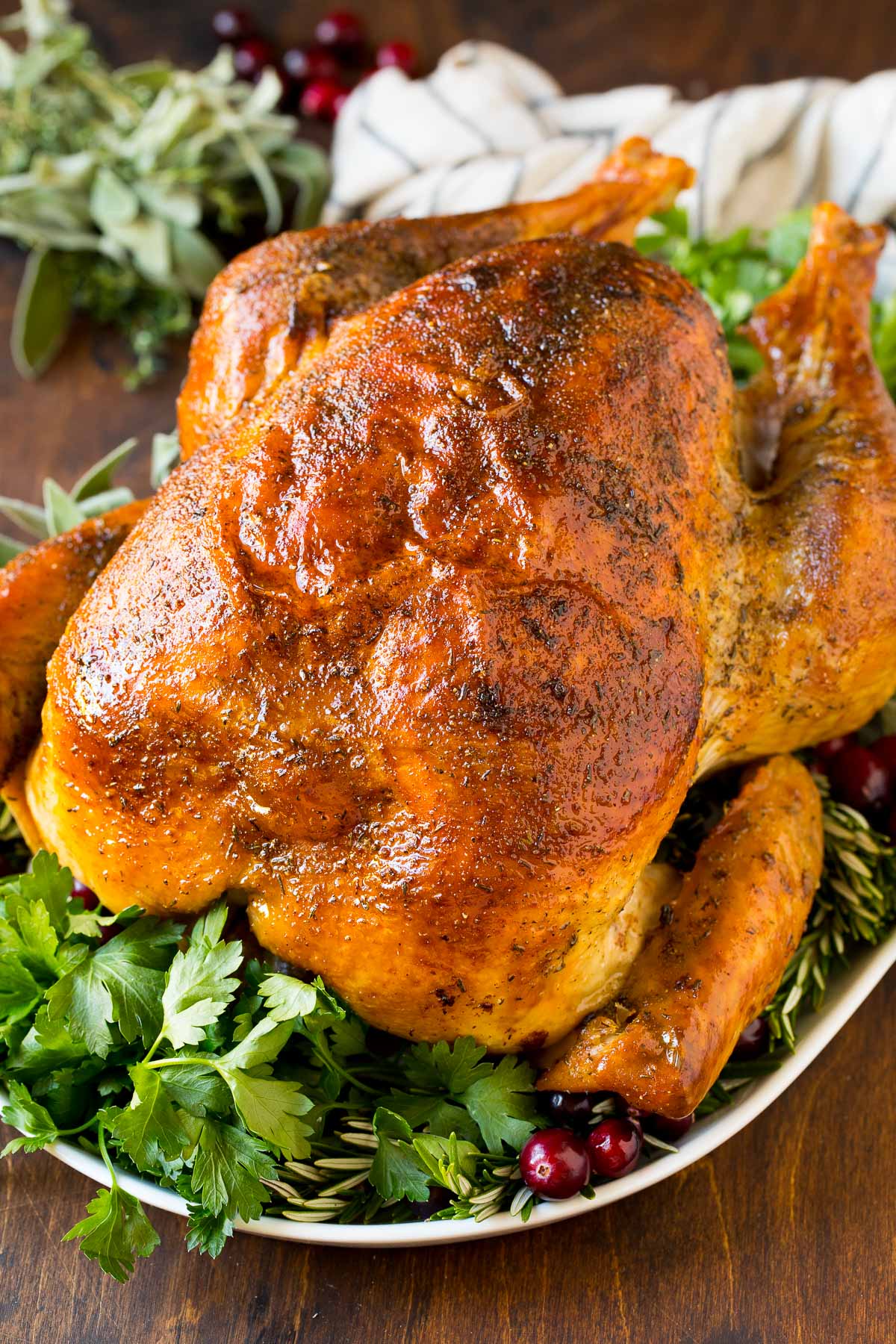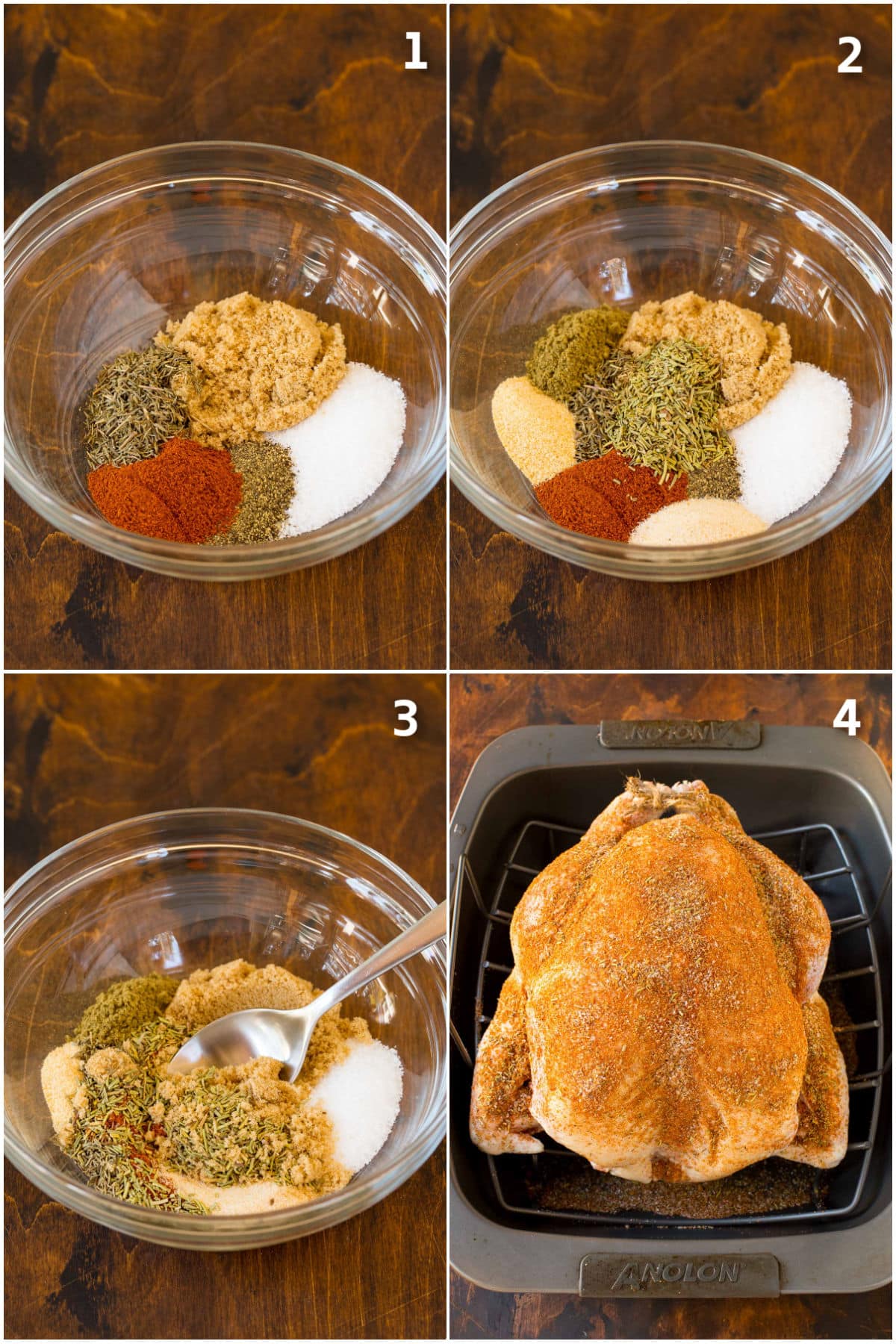This turkey rub is a blend of savory spices that come together to make the ultimate poultry seasoning. Homemade spice rub will add plenty of flavor to your Thanksgiving turkey, and also works well with chicken, pork and beef.
When I want to make a turkey that’s sure to impress, I use my homemade turkey rub as the primary seasoning agent. I serve my turkey with classic side dishes such as sweet potato casserole and cranberry relish for a memorable meal.
There are so many different ways to prepare a turkey, from brining to roasting to deep frying and more! This turkey rub turns an ordinary roasted turkey into something extraordinary. Best of all, it takes just 5 minutes to make!
This recipe is made with a variety of herbs and spices including salt, brown sugar, paprika, pepper, thyme, rosemary, sage, garlic powder and onion powder.
A well-crafted turkey rub can take your holiday bird from bland and dry to juicy flavorful perfection. But with so many seasonings to choose from how do you make a turkey rub that really delivers on taste? The key is blending the right balance of spices, herbs, salt, sugar, and pepper.
Follow this guide to learn about the essential ingredients for a stellar turkey rub plus tips for applying it evenly and getting amazing flavors
Top Ingredients for Turkey Rubs
Here are some of the most important components to include in a top-quality turkey rub:
Salt – Forms the flavorful base. Table salt works, but kosher salt is ideal since it adheres well and dissolves slowly. Sea salt also provides great texture.
Paprika – Adds color and a touch of sweetness. Smoked paprika is excellent, but any type works.
Onion powder – Provides onion flavor without moisture and complements the other spices.
Garlic powder – Essential for savoriness; use instead of fresh garlic which can burn.
Black pepper – Use freshly cracked peppercorns for the best turkey rub.
Thyme – This woody herb balances the other flavors beautifully.
Rosemary – The piney notes pair perfectly with turkey’s richness.
Sage – Earthy yet slightly sweet, sage is a natural fit for turkey rubs.
With just these core ingredients, you can make a simple but extremely tasty turkey rub. Feel free to experiment with other dried herbs like oregano, marjoram, and parsley too. Spices such as cumin, cinnamon, cayenne, and mustard powder also add flair.
Mixing and Measuring Your Turkey Rub
When combining ingredients for your homemade rub, use about:
- 1⁄4 cup salt
- 3 tablespoons paprika
- 1-2 tablespoons each of onion powder, garlic powder, pepper, thyme, rosemary, and sage.
For a one-time use rub, you can eyeball measurements. But for a perfect blend to reuse, follow measurements precisely.
Mix the dry ingredients well in a small bowl to distribute evenly. Break up any clumps of salt or spices. Store in an airtight container away from light and moisture.
Applying Turkey Rub for Maximum Flavor
To get the most out of your turkey rub:
-
Loosen the skin from the breast and push some rub underneath. This lets flavor penetrate the meat.
-
Generously coat the skin all over with more rub, massaging it in with your fingers.
-
Sprinkle cavity and back openings with rub too.
-
For best results, apply the rub 1-2 days before cooking so the seasoning can work into the meat.
-
If you forget to rub early, apply right before roasting and let sit for 30-60 minutes.
Take your time distributing the seasoning for even coverage. The salt and aromatic spices will form a flavorful, beautiful crust while infusing the turkey with taste.
Cooking Your Seasoned Turkey
Once your turkey is properly rubbed down, roast as you normally would, following your preferred time/temperature guidelines. The rub will impart flavor throughout the cooking process.
Basting the turkey while roasting will give even more layers of taste. For basting liquid, melt butter and combine it with chicken or turkey stock and aromatic herbs.
As the rub and basting liquids mingle, you’ll get a symphony of savory flavors in the crispy skin, moist meat, and pan juices.
Make the Leftovers Shine
Your homemade turkey rub will continue enhancing the flavor of leftovers. The seasonings permeate the meat so sandwiches, casseroles, and turkey soup all boast that great homemade taste.
Whip up some leftover turkey salad with mayo, chopped turkey, celery, onions, parsley, lemon juice and a dash more of the rub. You’ll never go back to bland turkey again!
With the right blend of spices and proper seasoning technique, your holiday turkey will be transformed. A flavorful, aromatic rub can make all the difference between dry, boring turkey and the best bird your guests have ever tasted!

Tips for the perfect seasoning mix
- This recipe makes the perfect amount of rub to use on a 10-12 pound turkey. If your turkey is larger, you’ll want to double the recipe.
- You can use fresh herbs instead of dried if you prefer; you’ll just want to triple the amount of fresh herbs compared to dried.
- This recipe calls for kosher salt, which is not the same as table salt. For best results, use kosher salt, which should be available in every grocery store.

Generously apply the seasoning to the outside of the turkey, then use your hands to rub it into the skin and meat. I also recommend loosening the skin of the turkey breast and thighs, and putting some of the rub under the skin against the meat for added flavor.
You can absolutely season a turkey the night before, in fact, I recommend doing this whenever possible. Leaving the rub on the turkey overnight allows for the salt and spices to penetrate the meat and makes for a more tender and juicy cooked bird. Place the rub on your turkey, then loosely cover it with plastic wrap and store it in the fridge for up to 24 hours before you plan to cook it.
Turkey pairs well with a lot of sweet and savory flavors such as brown sugar, maple, chives, thyme, rosemary, parsley, sage, basil, paprika, pepper, garlic, onion, lemon, and oregano. This spice blend is primarily savory, with just a hint of brown sugar to offset the salt, herbs and spices. The added bonus of the brown sugar is that it will help to create a golden brown crust on the turkey.

I happen to love this spice blend exactly as it’s written, but you can absolutely use other flavorings to customize this recipe to your taste.
- Sugar: You can use maple sugar, muscovado sugar or coconut sugar instead of the brown sugar. You can also blend honey, agave syrup or maple syrup with the spices to make a wet rub.
- Herbs: Feel free to add other herbs to the mix such as dried parsley, basil, marjoram, savory or oregano.
- Spices: Other great additions to this rub include cayenne pepper, mustard powder, smoked paprika or chili powder.
- Wet Rub: You can mix your spice blend with 2 tablespoons of olive oil or melted butter to make a wet rub.
- Smokey Rub: Use my smoked turkey rub if you’re planning to cook your bird in a smoker.
I like to make a double or triple batch of this rub and use it all year long on roasted chicken, pork tenderloin and roast beef. Make your holiday turkey extra special this year with this spice blend, and you’ll be sure to get rave reviews.
How do you make turkey rub?
Place the salt, sugar, herbs and spices in a bowl, then stir until everything is well mixed. Use the seasoning right away, or store it in an airtight container for future use.

